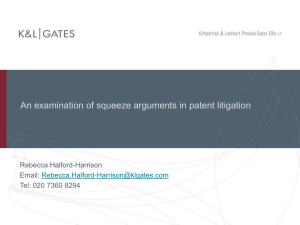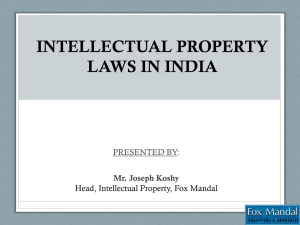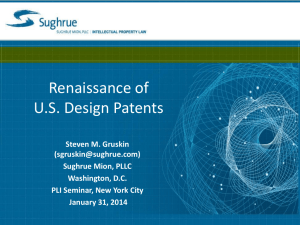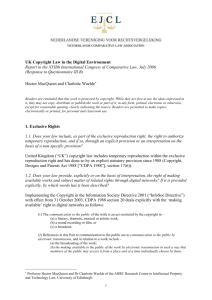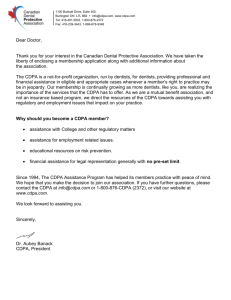Document
advertisement
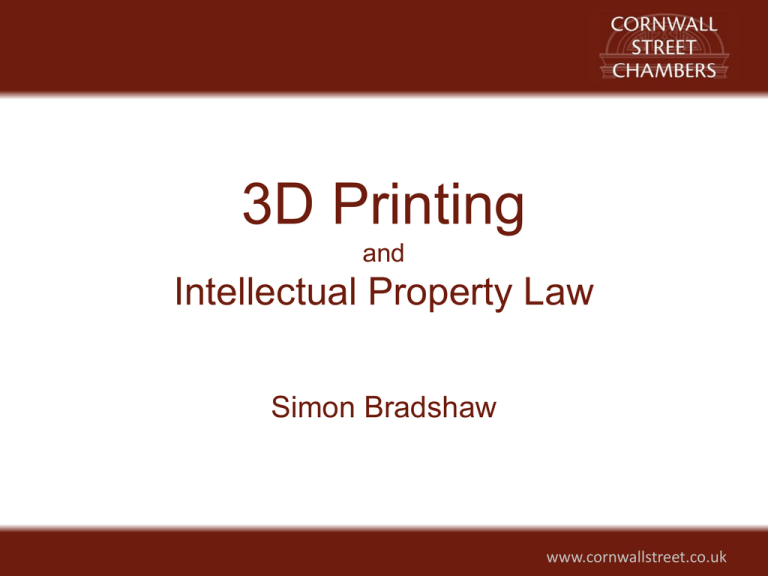
3D Printing and Intellectual Property Law Simon Bradshaw www.cornwallstreet.co.uk 3D Printing / Rapid Prototyping 2012 3D Print Show, London www.reprap.org 1981 2013 Relatively simple Homogenous No/few components Mechanical properties not critical Registered Designs Act 1949 1C (1) A right in a registered design shall not subsist in features of appearance of a product which are solely dictated by the product’s technical function. (2) A right in a registered design shall not subsist in features of appearance of a product which must necessarily be reproduced in their exact form and dimensions so as to permit the product in which the design is incorporated or to which it is applied to be mechanically connected to, or placed in, around or against, another product so that either product may perform its function. 7A (2) The right in a registered design is not infringed by— (a) an act which is done privately and for purposes which are not commercial; Copyright, Designs and Patents Act 1988 213 (3) [Unregistered] Design Right does not subsist in— (a) a method or principle of construction, (b) features of shape or configuration of an article which— (i) enable the article to be connected to, or placed in, around or against, another article so that either article may perform its function, or (ii) are dependent upon the appearance of another article of which the article is intended by the designer to form an integral part, or (c) surface decoration. 226 (1) The owner of design right in a design has the exclusive right to reproduce the design for commercial purposes— (a) by making articles to that design, or (b) by making a design document recording the design for the purpose of enabling such articles to be made. Parker v Tidball [1997] FSR 680 Dyson v Qualtex [2006] RPC 31 Copyright, Designs and Patents Act 1988 213 (3) [Unregistered] Design Right does not subsist in— (a) a method or principle of construction, (b) features of shape or configuration of an article which— (i) enable the article to be connected to, or placed in, around or against, another article so that either article may perform its function, or (ii) are dependent upon the appearance of another article of which the article is intended by the designer to form an integral part, or (c) surface decoration. 226 (1) The owner of design right in a design has the exclusive right to reproduce the design for commercial purposes— (a) by making articles to that design, or (b) by making a design document recording the design for the purpose of enabling such articles to be made. Copyright, Designs and Patents Act 1988 226 (1) The owner of design right in a design has the exclusive right to reproduce the design for commercial purposes— (a) by making articles to that design, or (b) by making a design document recording the design for the purpose of enabling such articles to be made. Non-commercial use does not infringe these rights (see Copinger and Skone James §13-144). A private user may make a design and may also make a design document (e.g. a 3D design file). Copyright, Designs and Patents Act 1988 4 (1) In this Part “artistic work” means— (a) a graphic work, photograph, sculpture or collage, irrespective of artistic quality, (b) a work of architecture being a building or a model for a building, or (c) a work of artistic craftsmanship. A 3D object may well be a sculpture. But what is a ‘work of artistic craftsmanship’? This is not a ‘work of artistic craftsmanship’ Lucasfilm v Ainsworth [2009] F.S.R. 2, as confirmed by Court of Appeal and Supreme Court Per Mann J, a WAC needs a level of artistic rather than utilitarian purpose. Does not infringe design right (‘must fit’ exemption). Private replication does not in any case infringe design right. Utiltitarian design, so not a WAC and no copyright in shape. Surface Artwork may be a more complex issue, however. Not relevant whether artwork is embedded in design or is on surface only (Lambretta). Section 52 CDPA may limit term of copyright in mass-produced artwork to 25 years. Beware 3D infringement of 2D original designs (‘Popeye’) BUT - Section 51 CDPA may apply (‘Teletubbies’) Design files are protected by copyright (Autospin v Beehive). It is not an infringement of such a copyright to make the item in question (Leyland). Design files are also ‘design documents’ within Section 51 CDPA 1988. It is not an infringement of a design document to make the item in question from it (Mackie v Behringer). Patents Act 1977 60 (5) An act which, apart from this subsection, would constitute an infringement of a patent for an invention shall not do so if (a) it is done privately and for purposes which are not commercial; BUT - Section 60(2) prohibits supplying the ‘means’ to allow a patent to be put into effect by a nonlicensee. Unclear if this applies to disseminating design files. Design Right Not infringed by personal use ‘Must fit / Must Match’ exemptions Does not include surface design Design right in design files not infringed by use Copyright Does not apply to utilitarian 3D objects Surface artwork covered (but reduced term if mass reproduction) Copyright in design files not infringed by use Patent Not infringed by personal use Not many patents likely to be infringed by 3D printers Issues from dissemination of design files? Trade Mark Not infringed by personal use Not infringed by use that is ‘not in trade mark sense’ The outlook for IP in Objects • 3D printing is moving from an industrial to a hobbyist / consumer technology. • If the evolution of computer technology is a guide, performance may develop rapidly. • Private, personal use of 3D printers will not, under UK law, infringe design rights, patents or trade marks. • UK copyright protection will not apply to most 3D object such a printer could reproduce. • Open source 3D printer designs and data formats, plus 3D printers that can copy themselves, may result in IP control of 3D objects becoming as problematic as IP control of music. (via Forbes.com) ‘The Intellectual Property Implications of Low-Cost 3D Printing’ S Bradshaw, A Bowyer and P Haufe, SCRIPTed 7.1 (2010) ‘The Rise of 3D Printing and its Implications for Intellectual Property Law – Learning Lessons from the Past?’ D Mendis, EIPR 35(3) (2013) ‘3D Printing Legal Update’ S Bradshaw, Computers & Law 24(2) (2013) simon.bradshaw@cornwallstreet.co.uk www.cornwallstreet.co.uk
